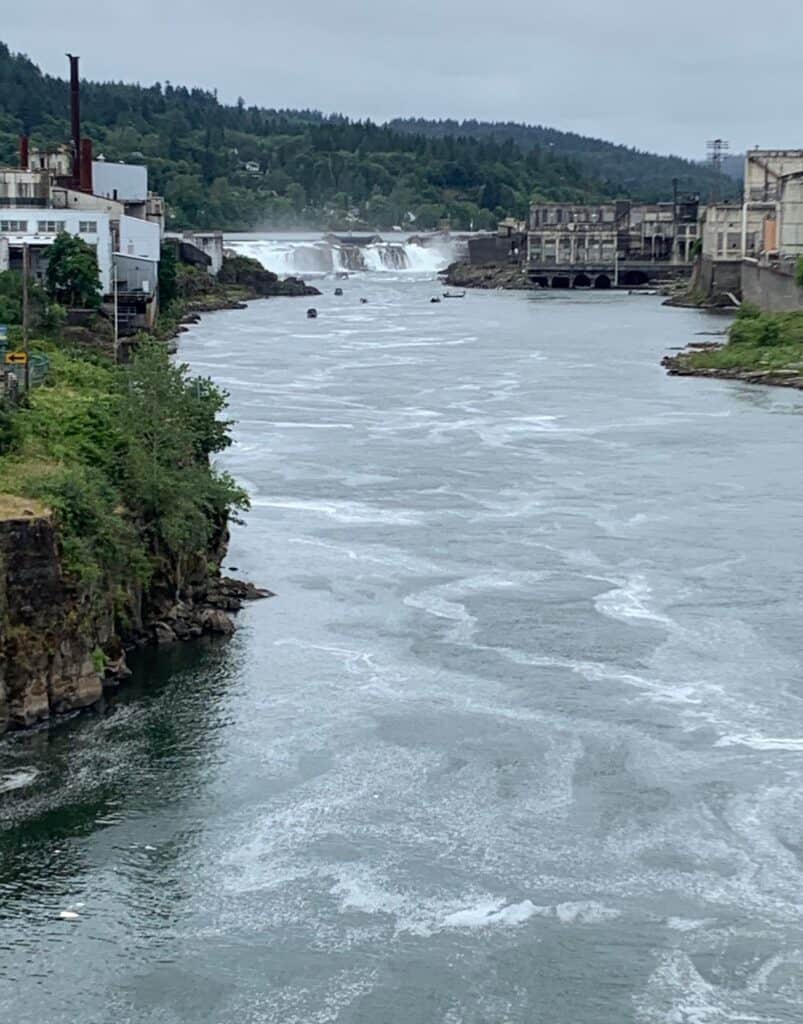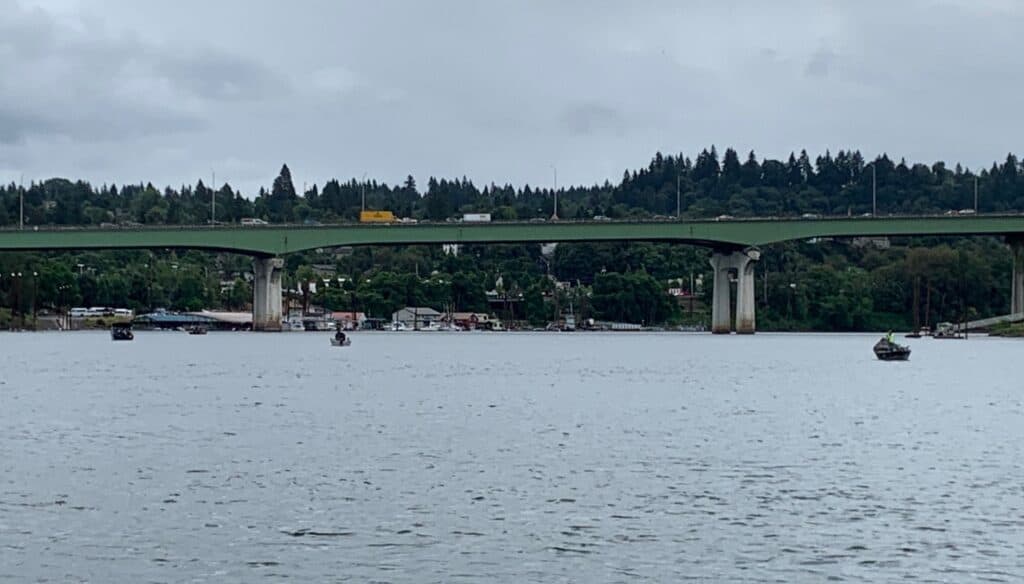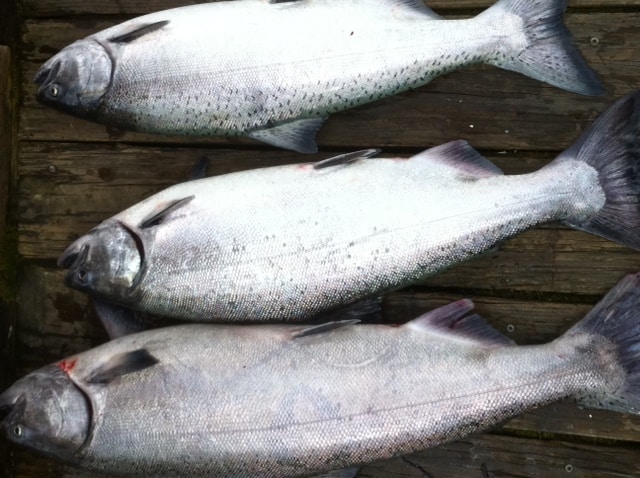The Columbia and Willamette rivers come together at Portland, joining Oregon’s two largest spring Chinook salmon runs in the state’s largest city.
While the big rivers are mostly boat fisheries, bank anglers from the metropolitan area can get in on the act on two good tributary streams: the Clackamas and Sandy rivers.
Remember that the Oregon Department of Fish and Wildlife requires a Columbia River Basin endorsement (in addition to the usual license and harvest tag) to fish for salmon, steelhead and sturgeon in these and other rivers that are part of the Columbia system.
Here is a brief look at each fishery close to Portland:
Clackamas River
The Clackamas is the Willamette River’s major tributary below Willamette Falls and also its main spring salmon destination in the lower river. Plenty of springers also cross the falls on their way to the best spring Chinook streams of the Willamette Valley.
When you’re done with this article, click the link below to read more articles about spring Chinook fishing farther into the valley and elsewhere in the region.
Like other spring Chinook runs around Oregon, the Clackamas returns tend to be cyclical.
Some years this fishery is booming, with several thousand of these incredible fish harvested between the mouth near Oregon City and Gladstone and the River Mill Dam near Estacada. The good fishing can stretch over multiple seasons.
However, the river is subject to low return periods as well, when anglers might have to put in a lot of time on the river to bring home a springer. Unfortunately, recent returns have been low.
When to Catch Spring Chinook
A handful of spring Chinook will venture up the Clackamas in early spring, even a couple in late winter, but most anglers will stick to the Willamette until better numbers of fish turn into the Clackamas in May.
Fishing continues good through June and often into at least the early part of July.
Angling tapers off by mid-summer, when non-angling rafters tend to take over the warm afternoons, but fish are still landed in August before the fish start to darken as they near spawning condition.
Where to Fish Spring Chinook
Bank access in the lower Clackamas can be found at the mouth at Clackamette Park, at High Rocks in Gladstone and Riverside Park in Clackamas.
Farther upriver, bank access locations include Clear Creek in Carver, the mouth of Eagle Creek at Bonnie Lure State Park and a long stretch at McIver State Park across the river from Estacada.
Drift boaters can launch or take out at McIver, Barton, Carver, Riverside and Clackamette parks, and at Feldheimer’s Road.
Learn more about Clackamas River Fishing.
Columbia River
The Columbia hosts the Pacific Northwest’s premier spring Chinook salmon run, sending fish not just to spawning grounds in its own upper reaches but to big tributaries like the Willamette, Deschutes and Snake rivers.
When to Catch Spring Chinook
In the Portland area, a handful of anxious anglers will vie for the first spring Chinook in the heart of winter by chasing them in January and February.
However, actual fish numbers are fairly low then and success rates are low.
By March, plenty of salmon anglers have joined the fleet, trolling bait and lures or anchoring up and letting the fish come to them.
Fishing only gets better in April and early May as the run nears its peak.
However, Oregon and Washington fish managers frequently are forced to limit the river to salmon fishing right when it is hitting its peak to minimize the impact on the protected wild runs that join the Columbia system’s larger hatchery runs.
Fishing Regulations
If you’re going to fish for salmon in the Pacific Northwest, get in the habit of watching for ODFW regulation changes to occur with relatively brief notice.
When possible, fish managers will reopen the lower river again to spring Chinook fishing, but it’s quite common for that to come after the bulk of fish have left the area.
Typically anglers are allowed to keep fin-clipped spring Chinook salmon in a good part of the river above Buoy 10 from January through the end of March, with the best fishing coming at the end of that period and into April when allowed.
Additional fishing time may be agreed upon by fish managers in Oregon and Washington so, again, keep an eye on the agencies for in-season changes. There also are opportunities to catch fin-clipped steelhead at this time, although catches for those are typically better in the late spring or summer.
Make sure to read all of the regulations before taking part in this ever-evolving fishery.
Where to Fish Spring Chinook
There is a moderate sport fishery in the lowest part of the river, where several hatchery programs release spring Chinook (such as Young’s Bay and Gnat Creek) primarily to support commercial anglers.
There also are some beaches and boat fishing spots in the Rainier and Clatskanie areas.
Most years, a large chunk of the lower river’s harvest comes from the stretch between the Longview and Interstate 5 bridges.
This stretch alone has produced well over 10,000 spring Chinook in excellent run years. Again, salmon runs are cyclical so fishing can be good for a few years and then fall way off.
Popular boat fisheries are located close to the mouths of major tributaries, including the Cowlitz, Lewis and Willamette rivers.
The Willamette actually has two mouths, the bigger one flowing almost directly into the Columbia right at Portland and its arm, the Multnomah Channel, which joins the Columbia near Scappoose and forms Sauvie Island.
Very popular boat spots in the Portland area just below I-5 include Frenchman’s and Davis bars and near Caterpillar and Sauvie’s islands, all in the general vicinity of the Willamette mouth and reached from launches on the main river, lower Willamette and Multnomah Channel.
Bank anglers have a shot at catching a spring Chinook from the beaches on Sauvie’s Island as well as additional beaches farther downriver around Rainier.
Above I-5, catch rates can lag a bit longer in March but often are quite good by April, but the key here is whether the area opens to fishing long enough for good numbers of fish to arrive.
Boat anglers can launch in the Portland, Troutdale and Columbia River Gorge areas to reach popular trolling lanes and anchor spots, including the area around the mouth of the Sandy River.
There is a smattering of bank access through this stretch, including below Bonneville Dam in the gorge.
For other fishing opportunities in the river, read Columbia River Fishing.
Sandy River
The Sandy River has a moderate run of spring Chinook salmon with very good bank access for boatless anglers.
The catch in a decent run year can be 800 or 1,000 springers.
When to Fish Spring Chinook
This run tends to be a little later than other springer fisheries. While a few appear in early spring, your odds will improve a bit by May, especially in the lower river, where boats concentrate.
But if you are fishing for the bank and want to hit the Sandy when the most fish come out, plan your trip on the upper river in June and July.
By that time there also will be summer steelhead distributed throughout the system to increase your odds of bringing home a big fish to eat.
Where to Fish Spring Chinook
Boat access is excellent in the lower river, with launches at Oxbow, Dabney and Lewis and Clark parks. Power boats can launch at Lewis and Clark and fish down to the Columbia. Those parks also have lower-river bank access.
Bank anglers fare well up higher in the system, with good access at Dodge Park, Cedar Creek (Sandy Fish Hatchery) and several other locations close to the city of Sandy.
Willamette River

Where else can you watch anglers boat mint-bright Chinook salmon on your lunch break if you work in a high-rise building in a major city? It’s quite possible in downtown Portland.
The lower Willamette River, from the mouth upstream to Willamette Falls (between Oregon City and West Linn), including the Multnomah Channel, is the only river in Oregon that can out-produce the Columbia when it comes to spring Chinook.
In good years, the river can put out tens of thousands of fin-clipped (hatchery produced) spring Chinook for anglers (more than 36,000 a decade or so ago, for example).
The Willamette fishery tends to remain open longer than the closure-prone Columbia, but it’s always safest to check for regulation updates whenever salmon are involved.
During down years, the Oregon Department of Fish and Wildlife may shut down spring salmon fishing on the lower river to make sure they get enough broodstock at hatcheries located on major tributaries in the Willamette Valley.
When to Catch Spring Chinook
Like the Columbia, anglers start trying to catch spring Chinook in the Willamette in mid- to late winter.
However, catch rates tend to be somewhat better by the time kids take Spring Break in late March, and quite likely they will peak in April or early May.
Devoted salmon anglers have discovered they can continue to pick up salmon here and there in the Willamette even into early summer before the run fades out completely.
Where to Catch Spring Chinook

Trollers work the entire river.
The lower section is popular below the launch at the St. Johns Bridge, including the head of Multnomah Channel and lower section close to the mouth at the Columbia.
Farther upriver, the Sellwood Bridge area can be very good.
Fishing also can be quite good from the mouth of the Clackamas (where some of the fish turn) to below Willamette Falls, where thousands of fish stage before heading over the torrent to reach the Santiam, McKenzie and upper Willamette river systems.
Up here, where the current is stronger, many anglers anchor in “hog lines” across parts of the river, dangling baitfish-wrapped wobbling lures near the bottom to entice salmon moving upriver.
Boaters also troll in the area but must be careful to avoid those at anchor.
While most spring Chinook salmon on the lower Willamette are hooked and netted from boats, bank anglers do have a shot at them.
There is a popular beach fishery for salmon and steelhead at Meldrum Bar and Clackamette Park, both near the mouth of the Clackamas.
There also is a long fishing dock on the west side of the river between the old Oregon City Arch Bridge and West Linn Paper Company.
Multnomah Channel
The lower river also includes Multnomah Channel, which a decent portion of the Willamette River run uses to cut on the inside of Sauvie Island.
The channel is narrower and fairly mellow, making it an excellent bet for even very small recreational boats. Trolling is most popular here.
There are boat ramps on the island and mainland sides of the channel between Portland and Scappoose.
For more information on Willamette River springer fishing, see guide Marvin Henkel Jr.’s spring Chinook fishing tips.
Also on this website, more articles about spring chinook fishing around Oregon:
- Willamette Valley’s Best Spring Chinook Fishing Rivers
- Spring Chinook Salmon Fishing on the Oregon Coast
- Spring Chinook Fishing in Central and Northeast Oregon
Return to Oregon Salmon Fishing Page
Oregon Resources
ODFW Weekly Fishing Report
ODFW Trout Stocking Schedule
Oregon Fishing Regulations
National Weather Service

